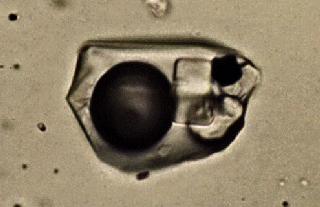MINERAL INCLUSIONS
Pre-eruptive dissolved volatile contents can be measured directly through the study of melt inclusions (MI) and fluid inclusions (FI).
A melt inclusion is defined as containing glass or crystallized glass.
A fluid inclusion contains no glass but rather one or more fluids at room temperature.
Because gases exsolve or come out of the liquid during eruption, the tephra erupted on the surface reveals little information on the original volatile content that existed in the magma chamber at depth. The tools that we use to measure preeruptive volatile contents directly include Fourier Transform Infrared spectrometry (FTIR) and Secondary Ion Mass spectrometry (SIMS).
Melt Inclusions

Five naturally glassy, bubble-free MI of various sizes from Plinian fallout deposit of the Tara Ignimbrite, Chile. Image is 700 microns.
Phenocrysts often trap small (1-300mm) fractions of silicate melt at magmatic temperatures and pressures during crystallization. Melt inclusions, incorporated into relatively incompressible phenocryst hosts like quartz, are able to retain the pre-eruptive volatile signature of the melt during eruption. This makes melt inclusions very useful tools in determining dissolved volatile concentrations directly. Through analytical techniques of the quenched inclusions, we can quantify the pre-eruptive concentrations of volatile gases such as H2O, CO2, S and Cl. Melt inclusion analyses can also provide a history of the evolution of a particular magmatic system.
Fluid Inclusions
Fluid inclusions are small droplets (<1mm) of fluid that like melt inclusions, are trapped within a phenocryst host. They are primarily two-phase, consisting of a liquid and a gas or vapor bubble. Fluid inclusions are remnant samples of very recent to ancient fluids that existed within the magmatic system. Studies of fluid inclusions allowed geologists to reconstruct the past history of the host rocks within which they are found.

Image from USGS
Thanks to several decades of strong efforts to improve analytical techniques, we can now identify and analyze the volatile content of these tiny inclusions. MI data can faithfully record magmatic processes, which other petrological tools could not reveal. We have discovered that H2O and CO2 are the most abundant volatiles in most silicate magmas and that they play a major role in controlling the rheological properties of magmas, including the viscosity and density.
It is interesting to note that much of what we know about km-sized magma bodies
comes from analyses of micrometer-sized features!
Additional References:
de Vivo, B. A. Lima, & J. D. Webster, Volatile in Magmatic-Volcanic Systems, Elements, 1, 19-24.
King P. L., T. W. Vennemann, J. R. Holloway, R. L. Hervig, J. B. Lowenstern, and J. F. Forneris, Analytical techniques for volatiles: A case study using intermediate (andesitic) glasses, American Mineralogist, 87, 2002.
Lowenstern, 1995. Melt Inclusions Come of Age: Volatiles, Volcanoes, and Sorby’s Legacy.
Lowenstern, J.B.(1995) Applications of silicate melt inclusions to the study of magmatic volatiles. In: Thompson, J.F.H. (ed.) Magmas, Fluid and Ore Deposits. Mineralogical Association of Canada Short Course 23, 71-99.